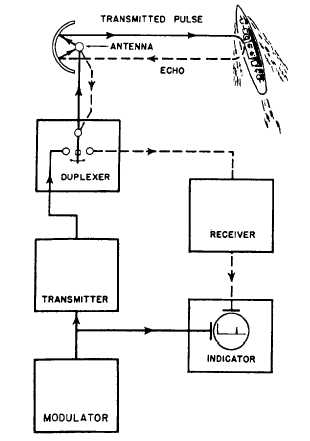types of radars use some variations of these units, and
we will explain those variations, as necessary in the next
chapter. For now, let’s look at the block diagram in
figure 1-4.
Modulator
You can see on the block diagram that the heart of
the radar system is the modulator. It generates all the
necessary timing pulses (triggers) for use in the radar
and associated systems. Its function is to ensure that all
subsystems making up the radar system operate in a
definite time relationship with each other and that the
intervals between pulses, as well as the pulses
themselves, are of the proper length.
Transmitter
The transmitter generates powerful pulses of
electromagnetic energy at precise intervals. The
required power is obtained by using a high-power
microwave oscillator, such as a magnetron, or a
microwave amplifier, such as a klystron, that is supplied
by a low-power rf source. (You can review the
Figure 1-4.—Block diagram of fundamental radar system.
construction and operation of microwave components
in NEETS module 11, Microwave Principles.)
Duplexer
The duplexer is essentially an electronic switch that
permits a radar system to use a single antenna to both
transmit and receive. The duplexer must connect the
antenna to the transmitter and disconnect the antenna
from the receiver for the duration of the transmitted
pulse. As we mentioned previously, the switching time
is called receiver recovery time, and must be very fast if
close-in targets are to be detected.
Antenna System
The antenna system routes the pulse from the
transmitter, radiates it in a directional beam, picks up the
returning echo and passes it to the receiver with a
minimum of loss. The antenna system includes the
antenna, transmission lines, and waveguide from the
transmitter to the antenna, and transmission lines and
waveguide from the antenna to the receiver.
Receiver
The receiver accepts the weak rf echoes from the
antenna system and routes them to the indicator as
discernible video signals. Because the radar
frequencies are very high and difficult to amplify, a
superheterodyne receiver is used to convert the echoes
to a lower frequency, called the intermediate frequency
(IF), which is easier to amplify.
Indicator
The indicator uses the video output of the receiver
to produce a visual indication of target information
including range and bearing (or in the case of
height-finding indicators, range and height).
TYPES OF RADAR SYSTEMS
Because of different design parameters, no single
radar set can perform all the many radar functions
required for military use. The large number of radar
systems used by the military has forced the development
of a joint-services classification system for accurate
identification of radars.
Radar systems are usually classified according to
their specific function and installation vehicle. The
joint-service standardized classification system divides
these broad categories for more precise identification.
1-5


